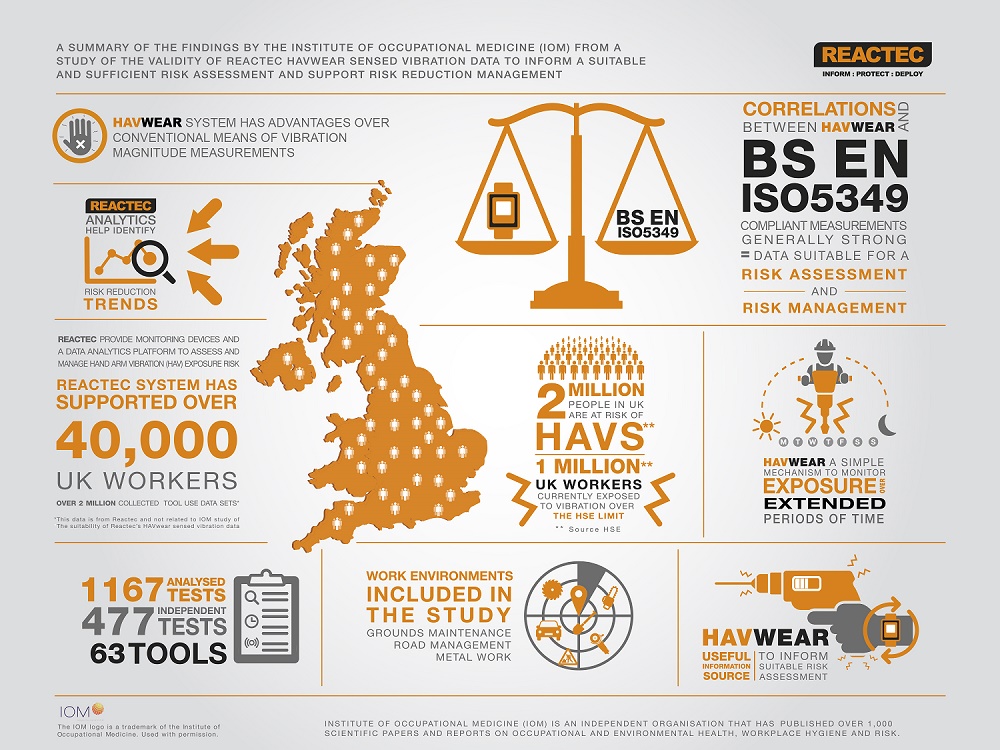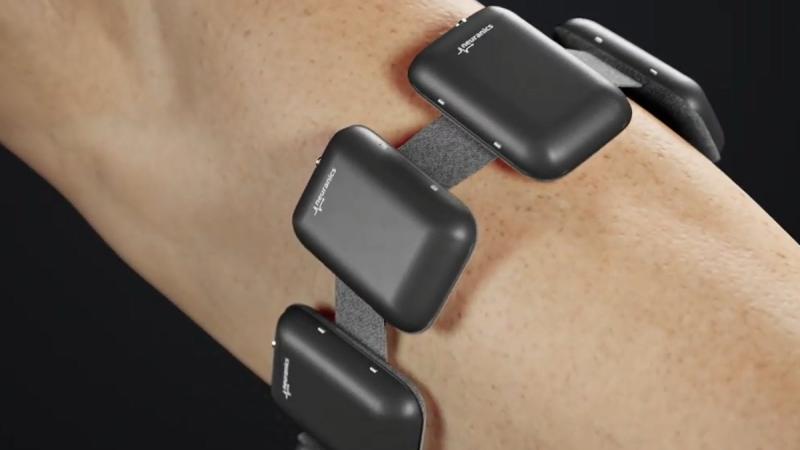A Game Changer For the Industry in the Prevention of One of the Most Common and Incurable Industrial Diseases
Edinburgh, 08 March 2018

In a study by one of the UK’s most respected occupational health and safety organisations, data from Edinburgh-based Reactec’s innovative wearable monitoring technology for Hand Arm Vibration* has been independently validated. HAVwear, a wearable wrist device that determines in real time an individual’s exposure to vibration during every day use of power tools, was independently tested in a study by the Institute of Occupational Medicine (IOM). The study, commissioned by Reactec, was led by Sheila Groat, Head of Health and Safety Services, and concluded that vibration data readily gathered by the HAVwear system during every day tool use provides a useful source of information to inform a suitable and sufficient risk assessment. Also the information gathered by the HAVwear system on a regular basis does inform the development of risk reduction control measures.
IOM conducted a rigorous review of Reactec’s award winning HAVwear system to assess its credibility as a risk assessment tool and whether the information obtained could support an effective HAV risk reduction programme.
The study shows that while the HAVwear system determines vibration magnitude data from the vibration transmitted to the person and not ‘on the tool’ in accordance with the existing standard BS EN ISO 5349-1: 2001, HAVwear DOES provide a range of vibration magnitude comparable with that produced by conventional methods.
The study confirms:
- HAVwear provides information comparable to that produced by conventional tool measurement techniques;
- The potential advantage of HAVwear over conventional means of risk assessment in being able to be more representative of the actual tool use than, for example, the use of trigger times and manufacturers’ data;
- HAVwear may also better reflect changes in tool use (or tool condition) over time than other approaches involving only limited measurements;
- HAVwear offers a simple mechanism where assessment of exposure, and changes in exposure, can be readily monitored over extended periods of time.
To read and download the full report please go to: www.reactec.com/iom_report
Reactec’s HAVwear practically monitors and gathers data based on the vibration exposure actually experienced by the tool / equipment user. The IOM study’s validation gives credibility to Reactec’s belief that their two million real use data records generated by the system over the past two years since its launch, are significant to individual organisations and potentially, in an anonymised aggregated manner, to industry bodies as a means of addressing the risk of developing the incurable and debilitating HAVS disease.
Commenting on the study, Jacqui McLaughlin, Chief Executive said:
“The result of this study is a game changer for the industry as our HAVwear system and the data it produces has been validated by the IOM as providing credible risk assessment while being practical for assessing risk on an everyday basis. These findings are significant as employers can confidently use HAVwear to determine real time vibration exposure which will ultimately help them reduce the risk of their workforce being exposed to HAV and developing the incurable HAVS condition.
“We designed and launched HAVwear two years ago to ease the assessment of HAV exposure and help employers reduce the risk faced by a workforce using vibrating tools. Employers are required to risk assess HAV exposure but doing so is made difficult by a need to establish the vibration magnitude of the tool in the process. The standards developed to measure tools exist but are intrusive and not practical to everyday use. This means that assessments are traditionally made with some sort of one-off, potentially inappropriate data. This is an exciting day for Reactec as we share the results of this study which tests the validity of HAVwear as a practical system to assess someone’s actual vibration exposure.”
Shelia Groat, Head of Health and Safety Services at the IOM, said:
“In the study commissioned by Reactec, IOM found that the data collected by the HAVwear system, during real use, is comparable to the range of vibration magnitudes achieved by conventional measurement devices. When gathered on a regular basis the HAVwear information can be used to identify risks to vibration exposure trends. As one of the most common industrial diseases in the UK, developing innovative measuring devices to assess occupational exposure is a significant move in the ongoing prevention of HAVS. IOM believes in protecting worker health; businesses and industry should not only adhere to regulatory requirements but be proactive in their approach to reducing exposure to hazards, including hand-arm vibration.”
Launched in 2016, HAVwear is a wearable wrist device that monitors in real time an individual’s exposure to vibration when using power tools. Reactec’s analytical platform provides cloudbased reporting which allows dynamic risk assessment and exposure reduction. HAVwear has enjoyed significant sales since its launch and is in use by a number of leading companies in the UK, including British Airways, Murphy Group, Morgan Sindall Balfour Beatty, the Environment Agency, Siemens and Babcock. Reactec is also targeting other industry sectors both in the UK and internationally.
* Hand Arm Vibration Syndrome (HAVS), which is also known as Vibration White Finger, is one of the most common industrial diseases in the UK. The condition is usually caused by the prolonged use of power hand tools, whose vibrations can damage the blood vessels, nerves, muscles and joints of the hand, wrist and arm. 300,000 people in the UK suffer from the condition, for which there is no known cure, only prevention.gave evidence to the Economy Committee at Holyrood on 13-Mar-2018 on the impact of the early stage risk capital market on economic growth in Scotland. Kerry Sharp of SIB also participated on the panel.
The session they were involved in starts 1 hour and 39 minutes into this link.





